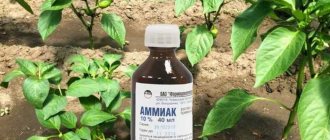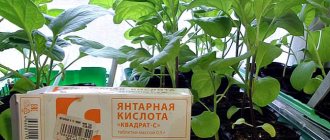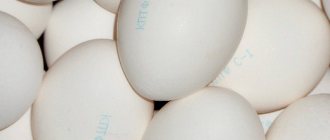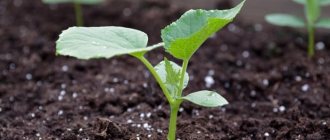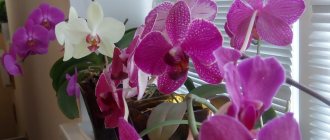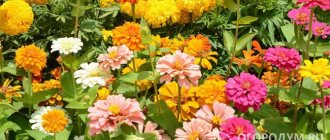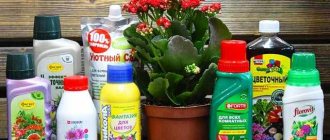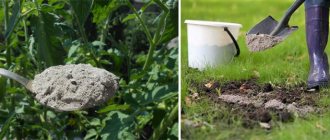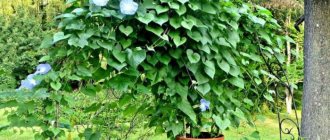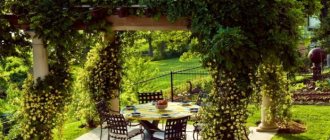Category: For flowers and indoor plants Reading time: 8 min · Views: 5,981
Everyone knows the property of ammonia to bring one to consciousness in case of loss of consciousness - not least because of the unbearably pungent odor. But less is known about the use of this liquid as a fertilizer. Read this article about how and why ammonia is used for plants.
Action mechanics
There is no mechanism for the accumulation of ammonia molecules in plants, or, more correctly, there is no “ammonia depot”. This means that it is impossible to overfeed any crops with ammonia - the plant simply will not absorb it, and an excess of such applied fertilizer will cause burns to the roots.
The fact is that the nitrogen contained in an aqueous solution of ammonia is absorbed by plants only after oxidation by air oxygen into ammonium form; destructor microorganisms do not participate in this process. What does this mean in practice? No nitrates are formed, if that's important to you. Well, it may be important in cases where after flowering no edible fruits or tubers are formed.
Possible harm
When using ammonia as a fertilizer for indoor flowers, you need to follow the basic rules:
- start fertilizing with low concentration solutions;
- do not use ammonia simultaneously with other nitrogen fertilizers;
- It is not recommended to use more than once a week.
In addition, it is worth remembering that ammonia is a toxic substance, so you need to:
- Fertilize only moist soil (immediately after watering);
- water only under the rhizome;
- prevent contact of the concentrated composition with the stem and leaves;
- observe the dosage.
Failure to comply with these measures may result in leaf burns.
Nitrogen fertilization
NH3H2O or, in the more familiar form of ammonium, NH4OH. That is, this substance is literally stuffed with nitrogen. Nitrogen in crop production is the green mass, the healthy and strong appearance of leaves and stems, and a developed root system.
But there are nuances in using ammonia as a top dressing that must be taken into account.
- Ammonia diluted in water in the dosages indicated below is largely used as a means of awakening flowering potted plants after hibernation. Plants that do not bloom can be content with this feeding no more than 2 times a month.
- The product is strong, so the 10% solution sold in pharmacies is not suitable in any case! Its use in its pure form will simply kill any plant. Therefore, the “impact” dose that forces plants to awaken after winter is 1.5-2 tablespoons of 10% ammonia per 5 liters of water.
- Plants should be fed with this product no more than once every 2 weeks, starting from about mid-February, when the length of daylight compared to the end of December becomes noticeable. Fertilizing is done regardless of the frequency of watering with ordinary water or the need of certain plants for nitrogen: this need must be satisfied in the composition of complex nitrogen-containing fertilizers.
- Diluting this liquid in water is also not so easy: ammonia will remain in it for a long time in layers, not wanting to mix. For complete dissolution, you need to use warm water, 30-35 degrees. After dissolving the ammonia in it, wait until it cools to room temperature.
- Fertilizing is carried out on damp soil, that is, the solution should be poured into flower pots 20-30 minutes after regular watering.
- Fertilizing plants with a solution is done strictly at the root! To do this, you need to have a special watering can with a thin spout, without a sprinkler at the end, which will allow you to pour the solution exactly under the root of the plant, preventing its drops from falling on the leaves, which can cause chemical burns. Despite the precautions taken, it is still possible for drops to accidentally fall on the green parts of the plant. To neutralize their effects, it is useful to spray the plants with plain water in the form of an aerosol immediately after watering.
- After the massive appearance of buds and the beginning of flowering, the dosage can be reduced by half - a tablespoon and a quarter of ammonia per 5 liters of water.
- In winter, such fertilizing can be avoided at all or limited to once a month.
How does nitrogen deficiency manifest itself?
The following signs observed in flowers can serve as a signal to apply nitrogen-containing fertilizers:
- The leaves have acquired a yellowish tint, the green color has lost its saturation.
- The stems of the plants have become brittle, the bush is not held in a bunch, if it was previously inherent in it, but is spreading out, moving apart in different directions.
- New buds do not appear, and existing ones die and dry out.
- Flowering, if it occurs at all, lasts a short time.
Peculiarities
The big “plus” of ammonia is “superfluidity”. It gives water with it the ability to penetrate into the most remote parts of the soil in a flower pot and is guaranteed to nourish the roots. Under natural conditions, this opportunity provides plants with additional sources of nutrients, because the roots can easily reach areas and depths of the soil where mineral or organic fertilizers are still present.
Transplanting plants into new soil every spring does not solve the problem - the flower will suck out all the nutrients in 2-3 months, and additional feeding will be needed. Replant more often? And this means injuring the root system.
Using large pots will also not give any effect other than root growth.
This is especially true for all types of geraniums: it is not for nothing that flower growers say that geraniums in large pots “get impudent” - they almost stop blooming, but they produce a surprising amount of greenery.
Regular feeding of indoor plants with a solution of ammonia in water over time, after about a year, leads to an increase in soil acidity. Since liming it under conditions of pot cultivation is impractical, it is better to replace the soil, stopping any fertilizing about a month before.
Application rates
The maximum dose for feeding is liquid in the concentration of the active substance - ammonia, in water - 1 tbsp. spoon of 25% solution per liter. You can apply fertilizer in this dose only once.
- For watering flower crops grown in apartments (including bulbs), a fertilizing solution is made based on 50 ml of 10% ammonia and 10 liters of water. Don't need so much? Recalculate.
- If you need to treat seedlings or perform foliar feeding of already well-rooted flowers that have begun to grow, make a solution of 1 teaspoon per liter of water.
Ammonia solution cannot be used as the main nitrogen fertilizer due to its inability to form nitrate and nitrite compounds in the soil. It can be used for feeding only as a means of initiating awakening after hibernation or as an emergency aid for plants during nitrogen starvation.
Application for treating indoor plants
An important condition for using ammonia is that it can be applied only after abundant watering has been done. Regardless of whether alcohol is used as a preventive measure or to treat diseased plants, in any case you must adhere to this rule.
There are several ways to treat plants with this substance:
- Spraying foliage. If a fairly concentrated ammonia mixture is used, you need to ensure that it does not get on the leaf plates, as such a solution can cause a burn. If during processing liquid does get on the leaves, you need to rinse them under running water and get rid of any remaining ammonia. Spraying should not be done using a fine sprayer. It is better to ensure that the composition gets only onto the ground. It should be taken into account that ammonium has increased volatility.
- Pest protection. In this case, a universal protective recipe with the addition of ammonia and water is most often used. The product must be applied to the ground at the foot of the plant (preferably using a sprayer). In this case, not only protection will be performed, but also soil disinfection. If the mixture is used to control pests, it is recommended to process it no more than once a week. As a rule, 1-2 procedures are enough. After this, you need to wait for the flowering period, and if the plant has recovered, then no additional treatments are required.
- Root feeding. This is the most common and best method of improving the growth of flowers; such fertilizing can also protect them from diseases and pests. Root watering is recommended during active growth, that is, from March to September. As a rule, such feeding is carried out 1-2 times a month. As soon as signs of nitrogen deficiency disappear, it is recommended to stop adding ammonia.
From midges and other pests
Many people use ammonia for indoor flowers to protect ornamental crops from parasites. Ammonia allows you to quickly eradicate them. The dosage of the product depends on which insects you need to get rid of.
There are several parasites that you have to fight most often:
- Drosophila. These are flies that usually appear in fairly humid environments. They begin to parasitize plants due to too frequent watering of the soil. The danger is that fruit flies can create a huge population in just a few days. To solve this problem as quickly as possible, it is recommended to water the soil for several days using a concentrated solution of ammonia. To prepare it, use 1 tbsp. l. For a 10% composition, add 1 liter of water. Similar feedings must be applied until the fruit flies completely disappear. After this, you need to give the plant a few days to rest and carry out one more final treatment to ensure that all fly eggs are removed.
- Aphid. These insects are more dangerous than fruit flies, as they actively feed on plant sap. To get rid of aphids, just add 1 tbsp. l. ammonia per 3 liters of water. The prepared solution must be applied at the root.
- Weevil. This pest is capable of feeding on absolutely any part of the plant, so it poses a great threat. In order to get rid of it, you need to add 1 tsp. ammonia per 1 liter of water and treat the soil daily. If it is decided to treat the above-ground part of the plant, then such measures can only be carried out with an increase in the amount of water. For example, in order to get rid of a weevil that parasitizes the foliage, you need to dilute 1 tbsp. l. ammonia solution in 5 liters of water. In this case, after spraying the leaf plates, you do not need to wash off the ammonia solution, however, such treatments should be carried out only in the case of a strong spread of insects that cannot be gotten rid of.
There is also a universal remedy that allows you to simultaneously feed the plant and protect it.
To prepare it:
- First you need to grate baby, laundry or any other natural soap. 100 g of soap shavings is enough.
- At the next stage, you need to dissolve the resulting shavings in 1 liter of hot water, the temperature of which is no more than 70-80C°.
- The resulting soap solution, without waiting for it to cool, should be poured in a thin stream into 4 liters of cold tap water. After this, the composition must be stirred very carefully and slowly so that no soap foam appears.
- You need to add 50 g of ammonia to the resulting liquid (corresponding to the volume of 1 bottle).
- It is necessary to use the resulting spray solution immediately after its preparation. Particular attention should be paid to the underside of the leaves. You can also apply this composition to the soil.
Ticks, scale insects and many other pests cannot tolerate not only ammonia, but also soap solution. This combination hits them very quickly and they disappear almost immediately. Also, the ammonia mixture is actively used in the fight against various flying insects, as well as ants.
It is worth noting that ants and small beetles are very sensitive to this smell, so if you place treated flowers on the windowsill, then insects will never fly into open windows.
The effectiveness of using such a product depends on the size of the pests. If the insects are large, then the ammonia particles will evaporate faster than they can harm them. Therefore, they continue to attack indoor plants.
To get rid of such pests, you need to prepare a soap solution (dissolve 1 piece of laundry soap in a bucket of warm water) and add 100 ml of ammonia to it. The leaves should be washed with the resulting solution.
For feeding
Ammonia for indoor flowers, the use of which is very cheap, is recommended to be used if the flower seems weak, its flowering becomes less abundant, and the leaf blades have become less saturated in color. In this case, it is customary to use nitrogen fertilizers, the best of which is an ammonia solution.
Scheme for using ammonia as a fertilizer for indoor flowers.
For 1 liter of cold running water, it is enough to add 1 tbsp. l. 10 percent solution. It is recommended to water flowers with this mixture only at the root. Feeding is carried out no more than 2 times in 2 weeks.
If at this moment the budding period begins, then in this case you should be extremely careful and either add more water to the solution, or perform treatment less often and only in case of urgent need. Spraying during this period is strictly prohibited; the solution is introduced only into the soil, directly under the root.
For disinfection
The biggest danger for flowers is that pathogenic bacteria and microorganisms can begin to develop on them. Often indoor flowers suffer from fungal infections.
It is better not to wait for the moment when the disease has already reached its peak stage and begin to carry out preventive treatments. To do this, use ammonia in different concentrations.
It is also recommended to use treatment with an ammonia solution if the grower is using a pot in which the plant previously died and wants to use the container for a new flower. There could be pathogenic microorganisms left on the pot, but you don’t want to throw it away. In this case, disinfection treatment is mandatory.
The solution can be prepared from 60 ml of ammonia, which must be added to 5 liters of hot water. You can also add a small amount of soap shavings to the composition, or treat the plant only with ammonia diluted with water.
After processing the containers, it is necessary to thoroughly wash the pots and rinse them. Young plants can be planted in such containers without any problems, since all pathogenic microorganisms are guaranteed to be destroyed.
Ammonia for plants as a means of protection
Since pests of indoor plants can enter the house through drafts (especially spider mites, which can travel tens of kilometers on their parachute webs), on clothes and shoes, in bags from stores along with purchased vegetables and herbs, the rule “my house is my fortress" does not work with them. They'll get there sooner or later anyway. Therefore, ammonia, which is almost always available in home first aid kits, will come to the rescue here too.
The most popular way to protect plants from pests is to add finely shaved laundry or baby soap to an aqueous solution of ammonia of a certain concentration.
Preparation of a protective solution
- Grate 100 grams of laundry or baby soap on a fine grater.
- Dissolve it in 1 liter of hot, 70-80 degrees, water.
- Pour the dissolved soap into 4 liters of cold, settled tap water in a thin stream, without vigorous stirring, so that soap foam does not form.
- A 50-gram pharmaceutical bottle of 10% ammonia is poured into the resulting liquid, slightly saturated with soap.
- Use the solution immediately as it is not stored.
The resulting mixture is sprayed over the entire plant from crown to base, paying special attention to the underside of the leaves. The fact is that mites, aphids or scale insects, against which such a soap solution is prepared, usually nest on the back side of the leaf, where the protective skin is matte and thinner. Which means it is accessible to destruction.
This soap-ammonia mixture will also be very effective against flying insects and ants.
Ants and wasps are generally very sensitive to ammonia. Those doses that will not have any effect on humans will be fatal to these creatures.
Soap is introduced into ammonia solutions mainly as a wetting agent and fixing the active substance on the leaves.
Rules for using ammonia on the site
In the garden and in the garden, a 10% solution of ammonia is most often used. It is sold in pharmacies under the name ammonia monohydrate or ammonium hydroxide. The drug is used in medicine as an external disinfectant and, in some cases, in the form of inhalation to stimulate respiration.
Rules of use for plants
In amateur gardening and vegetable growing, ammonia is used as a fertilizer containing nitrogen. But, more often than not, they do it wrong. The fact is that ammonia, even in an alcohol solution, is highly volatile, and practically no nitrogen reaches the plants. Ammonia itself can cause ammonia poisoning in crops.
To avoid problems, ammonia is neutralized in an acidic environment. This can be done in different ways:
- Table vinegar 9% at the rate of 6 tablespoons per tablespoon of 10% ammonia. For a tablespoon of 30% solution, 18 tablespoons are used.
- Citric acid. Ammonium hydroxide is diluted in a bucket of water, and a tablespoon of citric acid is added here.
- Whey at the rate of 1 liter per bucket of water in which ammonia was diluted.
It is important to apply the preparation early in the morning or in the evening to reduce the volatility of ammonia and protect plants from chemical burns. Ideal if the weather is cloudy.
On bright sunny days, it is better not to use ammonia for the garden.
Rules of use for soil
Many sources recommend using ammonia to deoxidize the soil. It is stated that the solution has an alkaline reaction, thereby helping to combat high acidity. In fact, the effect of using ammonium hydroxide for this purpose will be the opposite of what was expected.
In the soil, ammonium is converted by bacteria into nitrate, that is, nitric acid. As a result, even stronger acidification occurs, further requiring increased liming of the soil. The same effect is achieved by using ammonia as a fertilizer without neutralization with an acidic environment.
Nitrates that accumulate in the soil can also be hazardous to health. Therefore, it is impossible to use ammonia to combat high acidity.
Personal safety rules
The ammonia contained in ammonia is hazardous to health. People with respiratory diseases and high blood pressure need to be especially careful. To avoid health problems, you must follow the following rules:
- Prepare solutions for fertilizing plants only outdoors or in well-ventilated rooms.
- Protect your respiratory system with a respirator or mask.
- Do not work with the solution at high temperatures.
Be sure to ensure that there are no small children or animals nearby. For which ammonia vapors are more dangerous.
If possible, use gloves; they will protect your hands from the negative effects of the solution.
Application against pests
Midges and thrips
Dilute 25 ml of 10% ammonia in 2 liters of settled tap water. Water the plant at the root, adding 100-150 ml of solution to the soil.
Aphids and weevils
Against aphids, you can use not only soap, but also a regular aqueous solution of ammonia. Only for this you need not only to treat the above-ground part of the plant, but also to do root watering. To do this, prepare a solution of 50 ml of 10% product per 7 liters of water; the resulting amount is simultaneously sprayed and watered at the root.
Soil pests
As a preventive measure against soil pests, when planting, you can pour 50-100 ml of solution (10% ammonia per 1 liter of settled tap water) into the hole prepared for this purpose.
This mixture will create a stable connection with the soil, which will protect the roots from pests for at least a year.
General application features
The use of ammonia solution, unlike other nitrogen-containing fertilizers, does not lead to the accumulation of nitrogen compounds in plants. However, to process them safely and effectively, you need to know how to do it correctly.
- When used as a top dressing or insecticide, do not exceed the recommended concentrations and doses.
- For fertilizing, both root and foliar, choose a calm, preferably cloudy day. The best time is early morning or evening.
- Ammonia water is added to the soil only after abundant watering of the plants.
- Re-treatment of plants after watering or spraying is carried out no earlier than a week later.
- Ammonia should be diluted immediately before use to minimize the loss of the beneficial substance due to its volatility.
- It is necessary to use a toxic and caustic substance only outdoors, wearing safety glasses, a respirator and latex gloves.
Precautionary measures
Ammonia can enter the body not only, as doctors say, “orally,” but it can also be absorbed through the skin and mucous membranes. A person, unlike plants that do not have an “ammonia depot,” is subject to the cumulative action of ammonia, that is, it, having accumulated, can manifest itself suddenly. And poisoning with this substance is severe, with damage to the kidneys and urinary tract.
Therefore, the use of personal protective equipment in the form of latex gloves, masks and goggles is mandatory. If you notice a change in your health for the worse, immediately drink at least a glass of warm milk - only real milk, not milk-containing liquid from a package!
Aggressive ammonia vapors can also ruin many types of plastic coatings and even the insulation on wires.
Therefore, it is advisable to water and spray indoor plants with windows and doors open to create a draft without standing on the leeward side while doing this.
Safety precautions when processing with ammonia
Despite the fact that ammonia does not contain toxic substances, its vapors can be dangerous to human health and cause an allergic reaction and even poisoning.
In the process of preparing solutions, you must follow several important recommendations:
- It is imperative to manipulate the composition using latex gloves, goggles, an apron, and a respirator (if you don’t have one, you can get by with a regular medical mask).
- When preparing solutions, you need to make sure that the integrity of the container for mixing the components is not compromised and the substance cannot escape.
- Mixtures should only be prepared in a well-ventilated area. In order for the smell of ammonia to disappear as quickly as possible, you need to open the windows. In this case, the smell will not be felt, but even an imperceptible aroma is enough to repel pests.
- After preparing the solution, you need to thoroughly rinse the container in which the ammonia was located.
- Under no circumstances should people who are allergic to it work with the substance.
- When working with ammonia solution, you need to ensure that there are no children or pets in the room.
- When mixing water and ammonia, it is better to first pour the ammonia solution into the container and only then pour in the water in a thin stream. It is better to use a fairly deep container to prevent splashing of the substance.
- In the process of preparing the mixture, in no case should you violate the proportions and make a more concentrated composition.
- After preparation, the solution should be used immediately.
- Ammonia should not be mixed with chemicals or other substances. The exception is iodine, but it is not usually added to plants.
- Do not water or spray indoor flowers in hot weather. This may cause burns.
- If undiluted concentrated ammonia gets on your skin, wash it immediately. In case of severe burning or contact of the substance with the mucous membranes, it is better to consult a dermatologist.
Doctors point out that ammonia can enter the human body not only through inhalation of vapors, but also through the skin and mucous membranes.
This composition does not cause such harm to plants, since flowers have a so-called ammonia depot. That is, ammonia is not able to accumulate in plants. This substance accumulates quite quickly in the human body.
Due to the cumulative effect of the ammonia solution, damage to the kidneys and urinary tract can occur. Therefore, personal protective equipment is a prerequisite for working with compounds that contain even small amounts of ammonia.
Ammonia for indoor flowers, the use of which can improve the appearance and health of plants, can enter the respiratory tract. If a person has inhaled ammonia vapor and notices a deterioration in his health, then he needs to drink at least 1 glass of warm milk (natural with a high percentage of fat content).
This allows you to neutralize the effect of ammonia, however, if the concentration was too high and a person experiences intoxication, then you should immediately seek medical help.
For the same reason, specialists and experienced gardeners strongly recommend using a 10% ammonia solution. Only those people who already have experience in such activities can work with a more powerful concentrate.
Ammonia vapor can negatively affect the condition of plastic coatings, plumbing, and even destroy the insulation on wires. Therefore, after using this product, you need to rinse the used container thoroughly and do not turn off the water immediately, but pass it through the pipes a little.
If you follow the rules when working with ammonia, your indoor flowers will begin to bloom more luxuriantly. Using this product to treat plants will help get rid of pests. Ammonia solution is also used to disinfect flower pots and the soil itself. This has a beneficial effect on the condition and development of the root system.
Application in the garden
Ammonia solution is especially useful in the fight against pests such as all kinds of moths and butterflies that lay eggs, from which they will later hatch into all-devouring caterpillars. And also against soil inhabitants, cockchafers and their larvae, mole crickets and such a worst enemy of garden plants as wireworms.
And if a soap-ammonia solution works well against flying insects that lay eggs and larvae, then against underground inhabitants they use a simple remedy consisting of a solution of 50 ml of ammonia with a concentration of 10% in a bucket of ordinary water.
This solution is poured into holes intended for planting garden crops in an amount from 150 ml to one and a half to two liters, depending on what you plant: tomato, cucumber seedlings or tree seedlings.
Ammonia for pest control
Ammonia stimulates the human respiratory system, but has the opposite effect on insects - it blocks their breathing. In addition, the pungent odor repels most insects, and therefore ammonium hydroxide can be used to prevent pest attacks.
To better fix the solution on the leaves and stems, add laundry soap to it. It is strictly forbidden to use detergents containing chlorine for these purposes due to an undesirable reaction.
The working solution is prepared immediately before spraying. If you prepare it earlier, the ammonia will evaporate and the processing will not give the desired result. For the same reason, solutions are not prepared for future use and treatment with the prepared solution is not postponed until another day. Even a delay of an hour will render the treatment useless.
Aphid treatment
If aphids have been found on fruit trees, you can deal with them with ammonia. For these purposes, a tablespoon of ammonium monohydrate is diluted in a bucket of water, grated laundry soap is added and stirred until it is completely dissolved.
Bushes are treated in cloudy weather or in the evening. The aphid dies almost immediately after the solution hits it. The preparation remaining on the leaves and branches will repel ants, which carry aphids through trees and shrubs.
Anti-ant treatment
Ants themselves are not dangerous to most plants and trees, but they can carry aphids and therefore need to be controlled. To do this, you need to find all the anthills on the site and pour a solution of ammonia (100 ml / 10 l of water) inside. Consumption depends on the size of the anthill. As a result, most of the ants will die.
The same solution can drive red ants out of the house. They wipe floors and baseboards with it. You need to work carefully, protecting your respiratory organs and eyes. Be sure to provide good ventilation. The pungent smell will disappear in about half an hour, but the ants will smell its remnants and will avoid the house.
Mole cricket treatment
Using ammonia, you can scare away the mole cricket from the beds: the insect really does not like a strong smell and avoids its source. There is one safe way to achieve this goal.
You need to find the mole cricket’s passages and push a rag soaked in an ammonia solution into them. You can dilute it with water in a ratio of 1:2 or 1:3 if you need to treat a large area. The same rags can be laid out along garden paths.
The mole cricket will leave, but not for long. Once the ammonia has completely evaporated, the insect will return again.
Carrot fly treatment
To combat carrot flies in garden beds, you can use a weak solution of ammonia: 2.5 ml per 10 liters of water. Immediately after dilution, the solution is poured into a watering can and the entire bed is watered, trying not to miss a single plant.
For carrots, nitrogen is not so important, so plants can be treated no more than once every two weeks. It is not advisable to increase the dosage; in extreme cases, up to 5 ml per 10 liters, and only in case of severe damage to the beds by carrot flies. If the remedy does not help, you will have to purchase special medications.
Wireworm treatment
This pest is most dangerous for the immature root system of pepper and tomato seedlings. Therefore, treatment against it is carried out at the time of planting in open ground. The solution is prepared as follows:
- Take 10 ml of ammonium monohydrate.
- Dilute in 10 liters of water.
- Let stand for 30 minutes.
The last step is mandatory: it is necessary for most of the ammonia to evaporate.
Before planting seedlings in a permanent place, their roots are immersed in the prepared solution. You can water the plants with the same solution after planting if for some reason it was not possible to treat the roots.
The effect can be enhanced by mulching pepper and tomato plantings.
Weevil treatment
To treat strawberry plantings against weevils, you can dilute 2 tablespoons of ammonia in 10 liters of water. The resulting solution is used to treat the beds in early spring, when insect pests have not yet become stronger.
During the flowering period, strawberries should not be fed with nitrogen fertilizers, and ammonium hydroxide should not be used. This is why early weevil treatment is important.
Using ammonia for plants: benefits and harms
Ammonia is a colorless gas with an unpleasant urine odor. Its combination with water is ammonia or ammonia. Gardeners use these three concepts interchangeably.
Ammonia has a high nitrogen content (82%), which is the main “food product” for any plant. It is also found in large quantities in the air (72%), but plants can only absorb it from the soil.
A lack of nitrogen in the soil disrupts the production of chlorophyll in plants.
Signs of nitrogen deficiency or chlorosis disease:
- yellow or pale leaves;
- fragile stems;
- weak flowering;
- absence of ovary.
In such cases, fertilizing with nitrogen fertilizers is necessary. Ammonia can be used as them. It gives a visible effect after just a few uses. Positively affects the condition of the plant and guarantees productivity.
Its solution has an advantage over solid nitrogen-containing fertilizers:
- ammonium nitrate;
- urea.
An excess of the latter in the soil leads to the accumulation of nitrates (salts of nitric acid) in the roots, leaves, and most importantly, fruits. This is the problem with greenhouse and commercially grown vegetables and fruits. Fruits with a high content of nitrates can cause severe poisoning of the body.
It is almost impossible to “overfeed” plants with ammonia solution. Although if fertilizers are abused, this is possible.
Failure to comply with the dosage and frequency of fertilizing can lead to an increase in green mass to the detriment of flowering and fruit formation. In addition, excess nitrogen increases the risk of fungal diseases.
Using ammonia for feeding onions and garlic
Signs of nitrogen deficiency in onions and garlic are yellowing of their leaves. This happens for the following reasons:
- Consequences of return frosts,
- Lack of nutrition (nitrogen),
- The presence of pests, of which there are a lot of onion plants, but most often it is the onion fly.
If the leaves of onions or garlic turn yellow from frost, you can revive them with the help of anti-stress drugs - Zircon, Epin or hydrogen peroxide.
The lack of nitrogen can be compensated by fertilizing with green fertilizer or urea. Usually by this time there are already nettles and weeds, and it is quite possible to prepare a nutritious fertilizer from them. But if this is not possible, use an ammonia solution. But remember that nitrogen fertilizing should be used when the ambient temperature rises above +10ºС, otherwise the absorption of nutrients simply will not occur.
Fertilizing is carried out using a calculation prepared at the rate of 2 tbsp. l. for 10 liters of water. They feed only on wet soil, that is, it is necessary to first water the beds with plain water, and only after that water the leaves with a diluted solution. Or they do it after it rains.
Simultaneously with fertilizing, pest control is carried out, of which there are a lot of onions. The most malicious of them are the onion fly and the secretive proboscis. It is best to plant onions (sets) in late autumn before winter. In the spring, the onion puts out feathers early, its root system quickly develops, so by the time of summer the onion fly does not have the opportunity to lay larvae at the bottom of the onion. For preventive purposes, water the beds well with ammonia solution. For this, 2 tbsp. l. diluted in 10 liters of water and watered over the bush. Treatment must be carried out at least 3 times with an interval of 10 days.
When and how to prepare the remedy
Mix the ingredients of the mixture immediately before treatment, because ammonia, which has an effect on the parasite, is volatile. Its smell quickly disappears.
First, all the components of the mixture are added to a container with cool water, mixed, and only then ammonia is added. The solution is poured into a spray bottle, watering can, or used directly from a bucket.
How to use ammonia against pests on cabbage
The worst pests on cabbage when it begins to form heads are slugs. These land gastropods feed only on juicy young parts of plants; they love cabbage and strawberries. It breeds especially a lot in damp and rainy summers. They can not only destroy the crop, but also introduce viruses and bacteria. There are many methods of fighting slugs, but here I want to pay attention to treatments using ammonia.
To adjust the working solution, add 1 tsp to 1 liter of water. ammonia solution. Stir and treat the cabbage with the resulting solution, trying to spray them on the top and underside of the leaves. Repeated treatments are carried out no earlier than 10 days later, 2 more times. Don't forget to sprinkle the soil around the heads with wood ash or eggshells. Slugs will not be able to crawl through them without injuring their tender bellies. This will also scare them away.
Ammonia is unlikely to help as a top dressing, since at the moment the heads are set, it will no longer be so relevant.
Ammonia solution for garden strawberries
The crop absorbs almost no ammonia nitrogen. But, spraying helps fight pests and diseases. And strawberries have enough of them! Therefore, spraying should be carried out three times during the season.
- The bushes are sprayed for the first time when leaves appear. For 5 liters of water use 20 ml of ammonia. Laundry soap is also added to the solution. The treatment must be thorough; the leaves and soil must be sprayed. The solution helps destroy overwintered insects.
- Second time: after flowering you need to treat the ovaries. This must be done because of pests. For 5 liters of water use 1.5 tbsp. ammonia.
- Garden strawberry bushes are treated for the third time in September. Dilute 20 ml of ammonia and 3 drops of iodine in 5 liters of water. The bushes are treated completely.
What crops are watered with ammonia solution?
All crops need fertilizing with a nitrogen microelement. Nitrogen is especially needed for those green plants that grow on poor soils.
Fertilizing from a solution of ammonia is useful for the Solanaceae family: eggplants, potatoes, tomatoes, as well as vegetables: zucchini, peppers, cabbage.
Adding an ammonia solution to the soil will saturate berry and fruit crops with micronutrients: strawberries, currants, raspberries, cherries, plums, apple trees.
Nitrogen fertilizers, which are contained in an ammonia solution, are also useful for flowers. Without nitrogen support, not a single type of flower or flowering shrub will bloom lushly. Flowers need to be fed with nitrogen 3 times throughout the entire season.
Root crops are fed with nitrogen only at the beginning of the growing season, when leaves are developing. Legumes provide themselves with nitrogen. They absorb nitrogen from the air, and it accumulates in plants on root growths.
There is no need to use fertilizing with ammonia solution frequently. You need to start using it only with a small cone class=”aligncenter” width=”1200″ height=”628″[/img]
When to use ammonia solution
Ammonia —
it is a transparent liquid with a pungent (or rather sobering!) odor. You can buy it at any pharmacy. Ammonia concentration can be 10% and 25%. For use as fertilizer, use 10% ammonia.
In order for plants to use all their varietal qualities, so that they have time to grow during the growing season, and fruits, berries and root crops have time to ripen, additional feeding is needed. Today there is a wide variety of mineral fertilizers. But, only the microelement nitrogen is the most in demand. Thanks to it, the process of photosynthesis improves and regulates metabolism inside cells. Nitrogen is also responsible for the development of the root system and ground parts of plants.
In order for plants to use the microelements supplied to them, they must be in an accessible form. It is in this form that nitrogen is found in ammonia solution. Ammonia solution consists of water and ammonia.
Many people often confuse ammonia and ammonia, thinking that they are the same thing. No, ammonia is a mineral presented in colorless crystals. And ammonia is a liquid.
Using an ammonia solution, unlike other nitrogen microelements, will immediately give a positive result. Just five days after feeding, you can see how the plants come to life before your eyes, the color of their leaves will become richer, new shoots and ovaries will appear. Due to the pungent odor, many pests will simply leave the area treated with ammonia.
At home we use the drug as a snorting liquid that stimulates the nervous system.
In the garden and vegetable garden, aqueous ammonia solution is used in liquid mixtures. It is used for foliar fertilizer, for root feeding, and also for treating leaves.
An ammonia solution is used when seedlings are planted in open ground, when the plants form buds and ovaries. Feeding with this drug at the time of flowering and after the harvest is important.
The prepared solution is used to treat the crops in the morning or in the evening.
The main thing when using an ammonia solution is the air temperature. It should not be lower than +15°C. The fact is that in cool weather, the effect of ammonia solution is ineffective.
When working in a greenhouse, it is important to follow safety rules. Ammonia vapors are poisonous to the human body. In a greenhouse, frames and doors are opened when processing plants. Take the time to wear a protective mask or respirator when working with the drug. In case of severe poisoning, you should seek medical help.
When to use ammonia solution:
- At the beginning of summer, with sharp changes in night and day temperatures, which has a depressing effect on each plant.
- If there is a lack of the microelement nitrogen in the soil. This can be understood when the leaves grow poorly; they simply “sit” in place.
- And although the gardener may not be able to see this visually, the lateral roots stop growing, which indicates a lack of nitrogen. The plant simply stops developing.
- When the leaves begin to curl, there is clearly not enough nitrogen in the soil. To save themselves from dehydration in hot weather, plants curl their leaves. A weak root system is not able to saturate the ground part with nutrients and moisture. A solution of ammonia will strengthen the plants’ immune system and improve the development of the root system.
- If fragility of the stem and leaves is noticed, the lower leaves begin to turn yellow, the color of the foliage has become less saturated - it’s time to feed the green spaces.
- It is important to prevent the ovaries and buds from falling off. As soon as this is discovered, the plants must be saved immediately. Otherwise, the yield will decrease significantly.
How to strengthen tomato seedlings
To strengthen tomato seedlings, now is the time to fertilize with ammonia. Dissolve 1 tsp. ammonia in a bucket of water, pour the bushes at the root.
If you notice a wireworm or mole cricket on the site, then when planting seedlings in the ground, pour 0.5 liters of a medium-strength preparation into each hole.
After the tomato bushes are planted in the greenhouse, after 5-6 days, spray the “migrants” with a low-dose solution.
Organize the next spraying during flowering time to strengthen the tomato flowers. The next feeding will be useful for tomatoes when you harvest your first crop.
Experienced vegetable growers advise: for better fruit ripening during the autumn cold snap, spray the tomatoes with a weak ammonia solution.
Take the following precautions when using this drug:
- Prepare the solution outside.
- Do not inhale vapors of the substance.
- Use protective equipment: glasses, a respirator, a plastic apron and latex gloves.
Feeding seedlings of tomatoes, cucumbers and peppers with ammonia
When planting seedlings of tomatoes, cucumbers and peppers in an unheated greenhouse, even one made of polycarbonate, she experiences severe stress when the threat of return frosts arises. At low night temperatures, nitrogen from the soil cannot be absorbed by plants, so they are stunted in growth and their leaves turn yellow. Therefore, as soon as the weather settles and the threat of frost disappears, the plants in the greenhouse must be urgently fed. And the first nitrogen fertilizing is best done by spraying with an ammonia solution.
Already after the first feeding, you will notice a transformation of the plants: the leaves will acquire a rich green color, and active growth of the plant will begin. This feeding gives a strong impetus to the growth and development of the plant. In addition, this is an excellent remedy for pests, of which there are quite a few in the greenhouse. These are aphids, root-knot nematodes, tobacco thrips, woodlice and slugs, etc.
For the first feeding, dilute 2 tbsp. l. ammonia solution per 10 liters of water, if using a 10% solution, and 1 tbsp. l., if the concentration of the original drug is 25%. Stir the working solution well and water it over the damp soil with the diluted solution at the rate of 1 liter for each bush.
In total, at the beginning of the growing season, you need to carry out 2-3 feedings, but before flowering and fruiting begin. You shouldn’t get carried away with this type of feeding either, otherwise the plants will become fatty and all the energy will be spent on the growth of the tops. Do not forget to fertilize with potassium fertilizers 10-12 days after nitrogen fertilizing.
From garden pests
There is no worse disaster for a gardener than an invasion of aphids and similar sucking parasites. These small monsters can spread throughout the entire garden in a matter of days. They destroy leaves, young shoots and flower ovaries by sucking out cell sap, simultaneously transmitting viruses and fungal spores. Without taking timely measures, gardeners risk being left without a harvest.
Caterpillars on cabbage: 6 recipes for fighting without chemicals
Ammonia is harmless to plants, unlike effective chemicals. The ammonia solution not only effectively kills the suckers, but also serves as a nitrogen supplement. It can be used repeatedly, at any growing season, until the individuals are completely destroyed, without fear of a ruined garden or a poisoned harvest.
Whereas insecticides are used a maximum of 3 times per season and with a long break. Which is clearly not enough when aphids multiply at lightning speed.
Recipe for preparing the solution:
Ingredients:
- Water – 10 l.
- Ammonia – 50 ml.
Combine the components, mix and immediately treat the infected areas of the garden.
